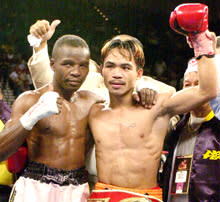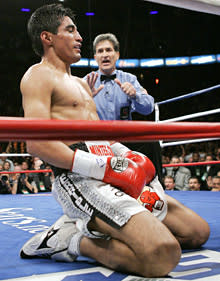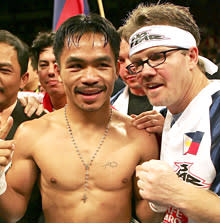Pacquiao's most pivotal moments
LAS VEGAS – When Manny Pacquiao arrived in the United States for the first time a little more than a decade ago, he was an unknown to all except boxing diehards.
Even trainer Freddie Roach wasn't familiar with him the day that Pacquiao first walked through the doors of his Wild Card Boxing Gym in Los Angeles.
In those 10 years, Pacquiao has become the top pound-for-pound fighter in the sport, boxing's biggest draw and one of the sports world's global icons.
Here are 15 of the key moments in a career that took Pacquiao, who fights Shane Mosley on Saturday in Las Vegas, from a homeless street urchin in the Philippines to one of the richest athletes in the world and the idol of millions:
15. Loss to Medgoen Singsurat, Sept. 17, 1999 – It's important to start the list of Pacquiao's defining moments with a loss. Pacquiao was just 21 and fighting for only the third time outside of the Philippines when he met Singsurat in a fight for the World Boxing Council flyweight belt.
Pacquiao had lost the title on the scale the day before when he was unable to make the flyweight division's 112-pounds weight limit. The fight went on. If Pacquiao won then the title would have been vacant, but if Singsurat won, he would have taken the belt.
Pacquiao was so severely dehydrated that he had little to offer, and fans who know him now as a blazingly quick, offensive fighter would be stunned to see him in retreat and taking punishment for most of the fight.
He was knocked out by a right hand to the body in the third round. The reason the loss is significant is that it forced him to jump not one, but two divisions, which was the beginning of his rise to greatness. He moved to super bantamweight in his next fight, then won his second world title on June 23, 2001, in Las Vegas with a dominant performance against Lehlo Ledwaba. That fight signaled the start of the "modern" Pacquiao era.
14. Victory over Ledwaba, June 23, 2001 – Ledwaba was the highly regarded International Boxing Federation junior featherweight champion and was scheduled to appear on the undercard of the Oscar De La Hoya-Javier Castillejo fight. When his opponent pulled out late, he was replaced by Pacquiao, who was a virtual unknown in the U.S.
Roach told everyone he came that week to keep an eye on his "new" fighter, and noted that Pacquiao would impress. Pacquiao dominated the fight and stopped Ledwaba in the sixth round.
13. Victory over David Diaz, June 28, 2008 – Roach considers this fight the turning point in Pacquiao's career, so it is hard not to include it on the list. There was no question going into the bout that Pacquiao was the more skilled fighter, but he was moving up to lightweight for the first time. More importantly, the fight marked the first time that Pacquiao was meeting a much larger opponent.
Pacquiao flashed a sign of things to come, allaying fears that size would be an issue by using his blazing speed to blitz Diaz before stopping him in the ninth. Pacquiao would essentially use the same formula to defeat the likes of De La Hoya, Ricky Hatton, Joshua Clottey, Miguel Cotto and Antonio Margarito.
12. Victory over Marco Antonio Barrera, Nov. 15, 2003 – Barrera was known as "The King of the Featherweights" prior to this meeting and considered one of the world's elite fighters. Pacquiao was gaining notoriety but still had a very low profile in the U.S.
His profile increased dramatically in the wake of the one-sided domination over Barrera. It was no contest from the start until the stoppage in the 11th round. Though Barrera would blame the loss on wildfires in California that disrupted his training camp, it became obvious to all that Pacquiao was a special talent.
[Related: Pacquiao-Mosley bout may signify boxing's return to network TV]
11. Unsuccessful run for seat in Filipino congress in 2006-07 – By the time Pacquiao decided to run for Congress the first time, he was already entrenched as a boxing star. By this point, he had already beaten Erik Morales twice and Barrera once and was being acclaimed as one of the better fighters in the sport.
But this was the first glimpse the Western world had of his interests beyond boxing and the start of the incredible journey he is on now.
10. Third victory over Morales, Nov. 18, 2006 – The series was even at one apiece heading into the rubber match, which was all Pacquiao. Pacquiao had stopped Morales in the 10th round in their fight earlier in the year, but it was a competitive fight until its late stages.
The rubber match was one-sided from the outset. Pacquiao showed a quality right hand for the first time, and Morales was unable to deal with the two-fisted attack. Pacquiao had come under great criticism after losing to Morales in 2005 for being a one-fisted fighter. Roach watched the tape of that fight and agreed.
The two spent the better part of the next year working to improve the right. It was one of the keys to his third-round knockout victory in the third fight with Morales.
9. First appearance on "Jimmy Kimmel Live," Nov. 3, 2009 – Pacquiao is now a regular on the ABC late-night talk show, but when he debuted on the Kimmel show in 2009, about two weeks prior to his fight with Cotto, it was huge because it was his first time in front of a large American non-boxing audience.
He came off as charismatic, charming and funny and helped increase his fan base dramatically.
8. Knockout of Ricky Hatton, May 2, 2009 – Pacquiao had established himself as the better fighter before this match, but size again was an issue. Though Pacquiao had beaten De La Hoya in his previous outing, many attributed it to De La Hoya being over the hill and making a mistake in his weight cut.
But Hatton was a bruiser at 140 pounds and was clearly in his prime. Pacquiao showed that not only could he handle the bigger fighters in this fight, but also that he could manhandle them. He knocked Hatton out with one shot in one of the most memorable finishes of his illustrious career.
7. Demolition of De La Hoya, Dec. 6, 2008 – De La Hoya was a former middleweight champion who returned to welterweight to face Pacquiao. De La Hoya was on the downside of his career, but most media figured he was simply too big for Pacquiao to handle.
But the difference between the men was startling. From the early stages of the fight until De La Hoya quit on his stool after the eighth round, it was all Pacquiao. It was the biggest pay-per-view audience of his career and firmly established Pacquiao as one of the top two draws in the sport.
6. Knockout of Cotto, Nov. 14, 2009 – If there were any Pacquiao doubters after the knockout of Hatton, he erased them all by stopping Cotto early in the 12th round. Cotto came into the fight in the pound-for-pound Top 20 and was a legitimate welterweight in his prime.
Similar to the way he did with Diaz and De La Hoya, Pacquiao blitzed Cotto with his combination of speed and power. Jaws dropped at the way Pacquiao not only dominated Cotto with his punches, but also at the way he easily took Cotto's powerful blows.
5. Signing with Golden Boy and Top Rank simultaneously in 2006 – Pacquiao was met at Los Angeles International Airport by De La Hoya, who presented Pacquiao with a suitcase filled with cash as an inducement to get him to sign with Golden Boy.
He did, but it turned out that Top Rank also alleged he had signed a contract with him. It was a sordid affair that wound up being decided by an arbitrator in Top Rank's favor after lawsuits had been filed, but what it showed was how valuable an attraction he was in the eyes of the sport's biggest promoters.
If they were willing to go that far to battle over him, there had to be something to him.
4. Victory over Joshua Clottey in Cowboys Stadium, March 13, 2010 – Beating Clottey was no major task at this point for Pacquiao, but what was significant was his ability to sell tickets in a gigantic venue.
Clottey had little appeal, either as a ticket seller or a pay-per-view draw. After talks to put on a fight with Floyd Mayweather Jr. fell through, Top Rank arranged the fight with Clottey with less than six weeks to promote it.
Pacquiao sold 50,994 tickets to the first boxing match at Cowboys Stadium, firmly establishing himself as boxing's premier ticket seller.
3. Election to Filipino Congress in 2010 – Pacquiao clearly learned from the mistakes he made on the campaign trail in his first run. He put together a flawless and highly organized campaign and won the election by an overwhelming margin.
If many viewed the 2006-07 campaign as a lark, this was clearly the move of a serious candidate committed to being a politician.
It also made him, as Arum now calls him, "a world figure."
2. Appearance on "60 Minutes," Nov. 7, 2010 – All of Pacquiao's previous accomplishments and the passion Filipinos around the world have for him led CBS' legendary news magazine to do a feature story on him prior to his bout with Antonio Margarito.
Correspondent Bob Simon's report was viewed by nearly 17 million people, providing an unequaled platform for a boxer.
It showed him as a man of substance as well as one of the world's elite athletes, and guaranteed that he would be a big hit in all future appearances in the ring by virtue of the name recognition he gained.
1. Arrival at Wild Card Boxing Club, 2001 – Pacquiao flew to the U.S. for the first time in early 2001 and arrived in San Francisco. He worked out at a gym in the East Bay, but wasn't impressed.
He later drove to Los Angeles and showed up at the Wild Card Boxing Club with Rod Nazario, who was his business manager. Nazario convinced gym proprietor Freddie Roach, a respected trainer and disciple of the great Eddie Futch, to allow Pacquiao to hit the mitts with him.
Roach was wowed by Pacquiao's combination of speed, power and condition and took him on full-time. The result is the greatest fighter-trainer combination in history. Roach has developed Pacquiao from a crude fighter into an elite boxer with impeccable technique.
Pacquiao now calls Roach his "boxing master" and doesn't make a move without carefully consulting Roach.
Under Roach's tutelage, Pacquiao won world titles at 122, 126, 130, 135, 140, 147 and 154 pounds, was named "Boxer of the Decade" and was a four-time choice of the Boxing Writers Association of America as its "Fighter of the Year."
The BWAA has named Roach its "Trainer of the Year" five times, including four of the last five years.
Had Pacquiao never walked into that gym, he'd probably never have become the world force that he has and Roach would never have gotten such acclaim.
Other popular stories on Yahoo! Sports:
• Fans rush to get Pacquiao's song release
• Browns call wrong player during NFL draft
• The wild resurgence of a 1970s sports fad




